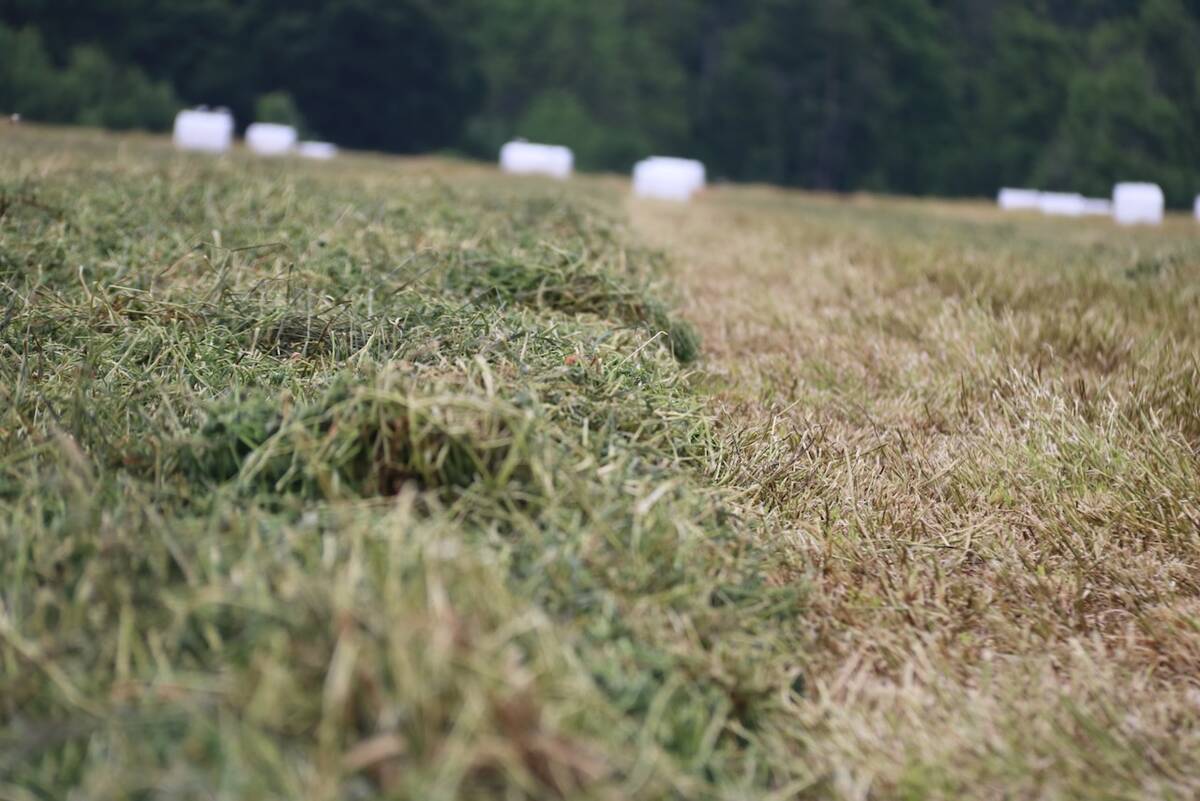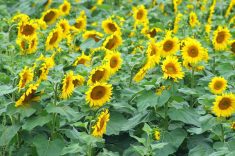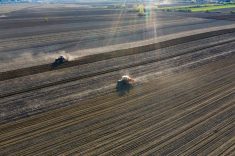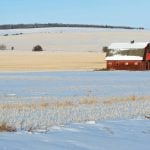
As central-Alberta farmer Merle Klassen claims the grand prize, the three-season long contest called the Canola 100 Challenge is all but history for their farm, except for a few hundred hours of quality field time with a fleet of John Deere equipment during the 2019 growing season.
Klassen, who along with family members operates Klassen Agriventures Ltd. — a mixed farming operation — at Linden, about one hour north of Calgary, produced the highest yield over the three years of the contest to win the grand prize: 100 hours of use of a full fleet of John Deere equipment. Known as the Agri-Prize contest it threw down the challenge to Canadian canola producers to produce a 100-bushel canola yield. (It had to be a third-party weighed and verified yield of at least 100 bushels over a continuous 50-acre parcel of land).
Read Also

New high-performance forage training program to launch in 2026
A new Canadian Forage and Grasslands Asssociation high-performance forage program will be a resource for farmers, agronomists and others in the forage sector.
The contest ran for three growing seasons — 2016, 2017, 2018 — on the basis that the first person to achieve 100 bushels won the grand prize. If no one reached the 100-bushel mark, the highest yield produced during the term of the contest would be the winner. That was Klassen Agriventures.
None of the several dozen farmers, primarily across Western Canada, who registered for the contest reached the magic 100-bushel yield figure. The Klassens produced the highest verified yield during the 2017 growing season with an 85.88-bushel yield average over a 50-acre plot. Coming in hot on the heels of that yield during the 2018 growing season was Kris Mayerle of KRM Farms at Tisdale, Sask., with an 82.95 bushel-average over the 50 acres. And the third top yield was Mike Nelson of Wetaskiwin, Alta., who set the bar during the 2016 growing season with 81.43 bushels per acre.
The Canola 100 Challenge — Agri-Prize, was the brainchild of Rob Saik, founder and former president of AgriTrend Agrology. Saik was on hand to announce the winner and present the prize at the Glacier FarmMedia Farm Forum Conference in Calgary in early December. The contest was co-sponsored by Glacier, AgriTrend and John Deere Canada.
Klassen’s first-place win
“It is definitely exciting to be the winner,” says Klassen. “In some respects it would have been nicer from an industry perspective if someone had hit the 100-bushel yield mark, but that will come. The contest made us think about ways to increase yield. That 85.88 bushels was the definitely the highest yield we’ve ever had on our farm.” In their diversified farming operation, Merle looks after annual cropping of about 5,500 acres, while two brothers look after the livestock side of the farm, which includes a 4,500-head beef feedlot, as well as poultry.
While Klassen applied some extra inputs and management to the field entered in the contest, he really credits the soil and fact 2017 was a “near perfect year” for canola growing conditions.
“We really didn’t do a lot extra in terms of inputs,” he says. “There was a bit more fertilizer and an extra fungicide treatment. But we had near ideal growing conditions and over the years that field had received a lot of manure as well as some compost.
The winning field was seeded with InVigor L233P canola, after a pre-seeding herbicide burndown, at 4.9 pounds per acre (based on 1,000 seed weight count). Recommended crop fertility included 120 pounds of added nitrogen, 10 pounds of phosphorus, 25 pounds of potassium and 30 pounds of sulphur. In-crop, the canola was treated with one pass of Liberty Link herbicide, tank-mixed with Centurion. Klassen also made four fungicide applications during the growing season. He included a bit of the micronutrient boron with the fungicide. And to top up fertility he dribble-banded some UAN pre-bolting. With some diamondback moth pressure on the field he also applied an insecticide. the crop was desiccated in early September and then straight cut about 10 days later.
Klassen says while it was the yield from 2017 contest field that won the Canola 100 Challenge, he was equally impressed with the yield on his 2018 contest plot, in terms of how well it did despite generally poorer canola growing conditions.
“Considering the year, it was an exceptional crop,” says Klassen. “We only had about seven inches of rain and the 50-acre plot had an average yield of about 65 bushels per acre, and the yield was about the same over the whole quarter section — in that 60- to 65-bushel range.” The 2018 contest field was seeded into pea stubble and the field also had a long history of receiving manure as well as some compost in the past.” About three miles away another canola field yielded only 20 bushels per acre. “Again what stands out to me is how manure and compost benefits soil organic matter and fertility,” he says.
Great Canola Year at Tisdale
In northeast Saskatchewan, Kris Mayerle says while 82.95 bushels of canola didn’t win the contest, it was a winner crop for their farm.
“It was the highest yield we’ve ever had,” he says, as well as an important learning experience as he looks for the balance or the “happy medium” of how many inputs he can afford to put into a crop and achieve a reasonable economic return.

For the 2108 canola contest field, Mayerle “went pretty heavy on the inputs”. He applied about 250 pounds of nitrogen, 76 pounds of actual phosphate, 60 pounds of potash, and using a long-lasting sulphur product called Bio-Sul three years ago, sulphur levels were still at recommended levels. Along with fertility and in-crop weed control, the InVigor L233P canola crop received two fungicide treatments including some boron with the second fungicide application.
Involved in all three years of the contest, Mayerle says he applied some extra inputs in 2016 and produced an extra eight bushels in yield, while in 2017 extra inputs produced only a five-bushel yield increase. Neither of those really paid.
“In 2018 I went heavier on the inputs and applied about $85 more per acre of inputs on the contest plot then over the rest of the field,” he says. “That produced a 16 bushel-per-acre yield increase. If you figure that out at $11 per bushel canola price that is a gross extra return of $176 per acre. I spent $85 per acre to achieve those extra bushels, so that left a net realization of about $90 per acre, which I consider a fairly reasonable return.”
On a second field he had also entered in the Canola 100 contest in 2018 he only supplied about $50 extra in inputs and only achieved a four- to five-bushel increase — about break even.
“Part of the reason I was interested in this contest was to determine that cut-off point,” says Mayerle. “I saw this year that the higher inputs did produce a greater return per acre. Am I going to provide that level of inputs over the whole farm next year? Probably not. What I do want to find is that happy medium where I apply sufficient inputs that helps me produce a more consistent 60 to 65 bushel per acre yield over the whole farm, with a reasonable return. That’s the goal.”
Mayerle says the contest has encouraged their farm to “think outside the proverbial box” in terms of yield. “Five years ago, I didn’t think achieving an 80-bushel yield was even possible,” he says. “Now I can see that the potential is out there. Generally, our yields in 2018 were some of the highest. This past growing season was the year for this northeast region to grow canola. Are we going to see that every year? We can apply all the inputs we want, but if the weather and growing conditions don’t co-operate, it can quickly be at a loss. So as we try to find that happy medium we have to figure in a bunch of factors — soil type, level of inputs, what’s the weather going to do. There are a lot of variables.”
Back at Linden
In a mid-December Grainews interview, Klassen says he had yet to figure out the details of how the line of John Deere equipment will be used on the farm. Klassen will work with the local Cervus Equipment John Deere dealership in nearby Trochu. “Basically, I believe the plan with everything is to pick up each piece as we need it, use it for 100 hours and bring it back when we’re done,” says Klassen.
The farm had sold one of its older air seeding units last fall, leaving them with one older unit. He says a new John Deere air drill may have enough capacity for them to just use one machine this coming spring. They will probably use their own as well as the new Deere sprayer during the season, and since they cut forage crops for silage as well as swath canola, it will no doubt be handy to have two swathers in the field. He has yet to decide if the new John Deere combine can handle all of their crop, or if they will need to use a second one of their own.
“We will figure out the details as we go, but certainly if anyone is looking at new equipment, 100 hours provides a really good demo opportunity,” he says.
















